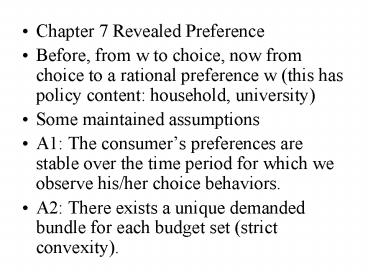Chapter 7 Revealed Preference - PowerPoint PPT Presentation
1 / 19
Title:
Chapter 7 Revealed Preference
Description:
... t period is better than base (intuitively, when income grows faster than prices, ... base is better than t (intuitively, when prices grow faster than income, ... – PowerPoint PPT presentation
Number of Views:87
Avg rating:3.0/5.0
Title: Chapter 7 Revealed Preference
1
- Chapter 7 Revealed Preference
- Before, from w to choice, now from choice to a
rational preference w (this has policy content
household, university) - Some maintained assumptions
- A1 The consumers preferences are stable over
the time period for which we observe his/her
choice behaviors. - A2 There exists a unique demanded bundle for
each budget set (strict convexity).
2
- Def If (x1, x2) is chosen at (p1, p2, m), (y1,
y2)? (x1, x2) and p1y1p2 y2m, then (x1, x2) is
directly revealed preferred to (y1, y2). Denote
this by (x1, x2) d (y1, y2). - Note that revealed preferred is solely about
choices though choices are related to
preferences. - A3 The consumer is always choosing the best
s\he can afford (model of behavior).
3
Fig. 7.1
4
- From revealed preference (d) to preference (w)
Suppose (x1, x2) is directly revealed preferred
to (y1, y2) and the consumer is choosing the best
s\he can afford, then (x1, x2) s (y1, y2). - Def If (x1, x2) d (y1, y2) and (y1, y2) d (z1,
z2), then we say that (x1, x2) is indirectly
revealed preferred to (z1, z2). Denote this by
(x1, x2) id (z1, z2). Allow indirect revealed
preference for chains of observed choices
longer than 3.
5
Fig. 7.2
6
- Def If either (x1, x2) d (y1, y2) or (x1, x2) id
(y1, y2), we say (x1, x2) is revealed preferred
to (y1, y2). Denote this by (x1, x2) r (y1, y2). - Give an example to recover preferences.
- We now question A3 (the idea is A1 and A2 are
OK). How do we know whether the consumer is
maximizing if we only observe choices?
7
Fig. 7.3
8
- The weak axiom of revealed preference (WARP) if
(x1, x2) d (y1, y2), then it cannot happen that
(y1, y2) d (x1, x2). (draw) (WARP is a weak and
logical implication of consumers maximizing
behaviors) - An example
9
Fig. 7.4
10
obs p1 p2 x1 x2
1 1 2 1 2
2 2 1 2 1
3 1 1 2 2
11
Bundles
1 2 3
Prices 1 5 4 6
2 4 5 6
3 3 3 4
12
- The strong axiom of revealed preference (SARP)
if (x1, x2) r (y1, y2) and (x1, x2)? (y1, y2),
then it cannot happen that (y1, y2) r (x1, x2).
(SARP is a necessary and sufficient condition for
optimizing behavior, but the proof is beyond the
scope of this course.) (If choices satisfy SARP,
then we can construct preferences for which the
observed behavior is optimizing.)
13
bundles
1 2 3
1 20 10 22()
prices 2 21() 20 15
3 9 15() 10
14
- Index numbers
- Compare the consumption bundles of a consumer at
two different times. Let b stand for the base
period, t some other period. - At t prices (p1t, p2t), consumption (x1t, x2t)
- At b prices (p1b, p2b), consumption (x1b, x2b)
15
- Quantity index compare the average consumption
of these two periods, naturally could use the
prices to be the weights - Laspeyres quantity index (use base price)
Lq(p1b x1t p2b x2t)/(p1b x1b p2b x2b), if
Lqlt1, at base price, base is chosen over t, so
better off at base than at t (Lqgt1?) - Paasche quantity index (use t price) Pq(p1t x1t
p2t x2t)/(p1t x1b p2t x2b), if Pqgt1, at t
price, t is chosen over base, so better off at t
than at base (Pqlt1?)
16
- Price index compare the average price of these
two periods, naturally could use the quantities
to be the weights - Laspeyres price index (use base q) Lp(p1t x1b
p2t x2b)/(p1b x1b p2b x2b), if Lplt1 (says
nothing since prices different) - Paasche price index (use t q) Pp(p1t x1t p2t
x2t)/(p1b x1t p2b x2t)
17
- Define a new index of the change in total
expenditure M(p1t x1t p2t x2t)/(p1b x1b p2b
x2b). - LpltM p1t x1b p2t x2b ltp1t x1t p2t x2t, t
period is better than base (intuitively, when
income grows faster than prices, better off after
this change) - PpgtM p1b x1b p2b x2bgt p1b x1t p2b x2t, base
is better than t (intuitively, when prices grow
faster than income, worse off)
18
- Social security indexing so that base
consumption is still affordable, then t cannot be
worse than base
19
Fig. 7.6

